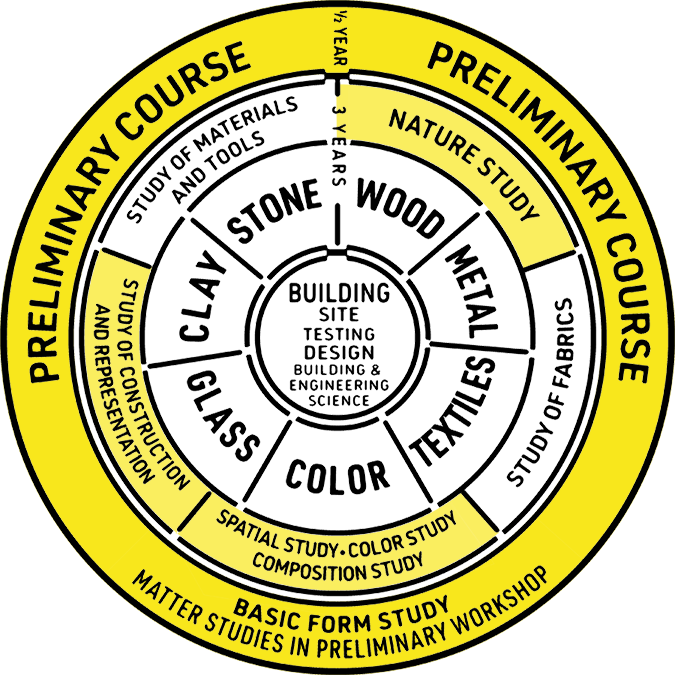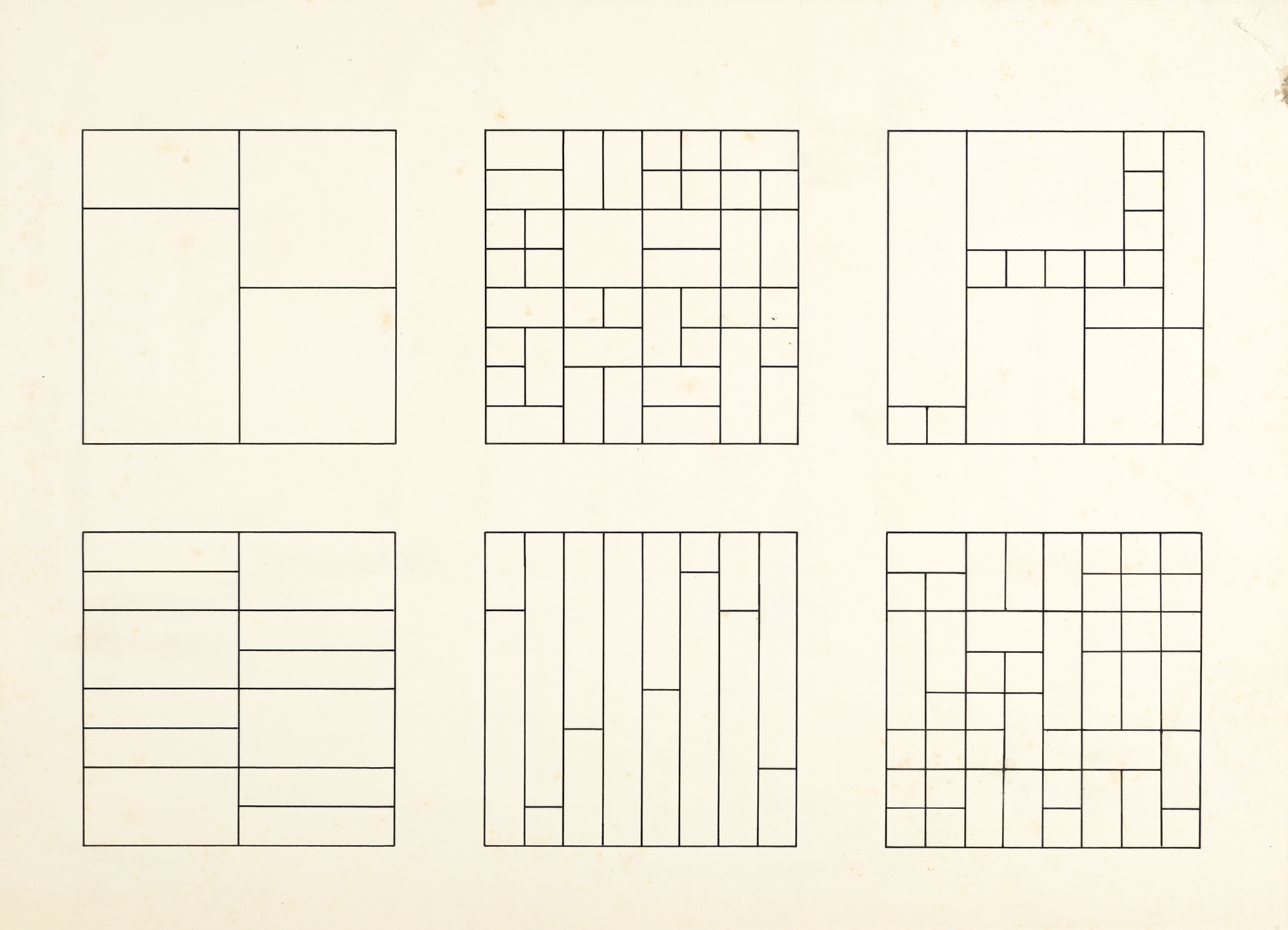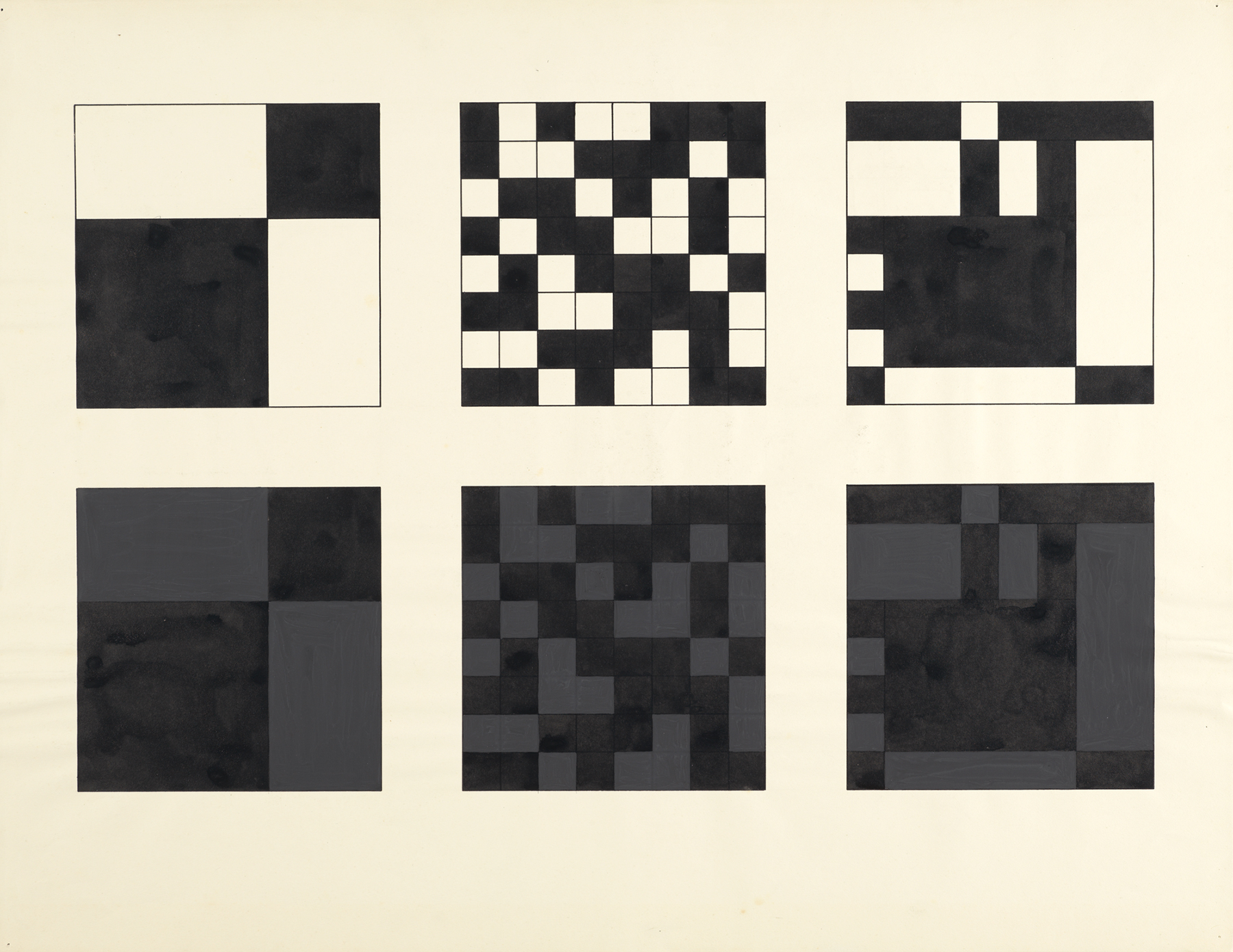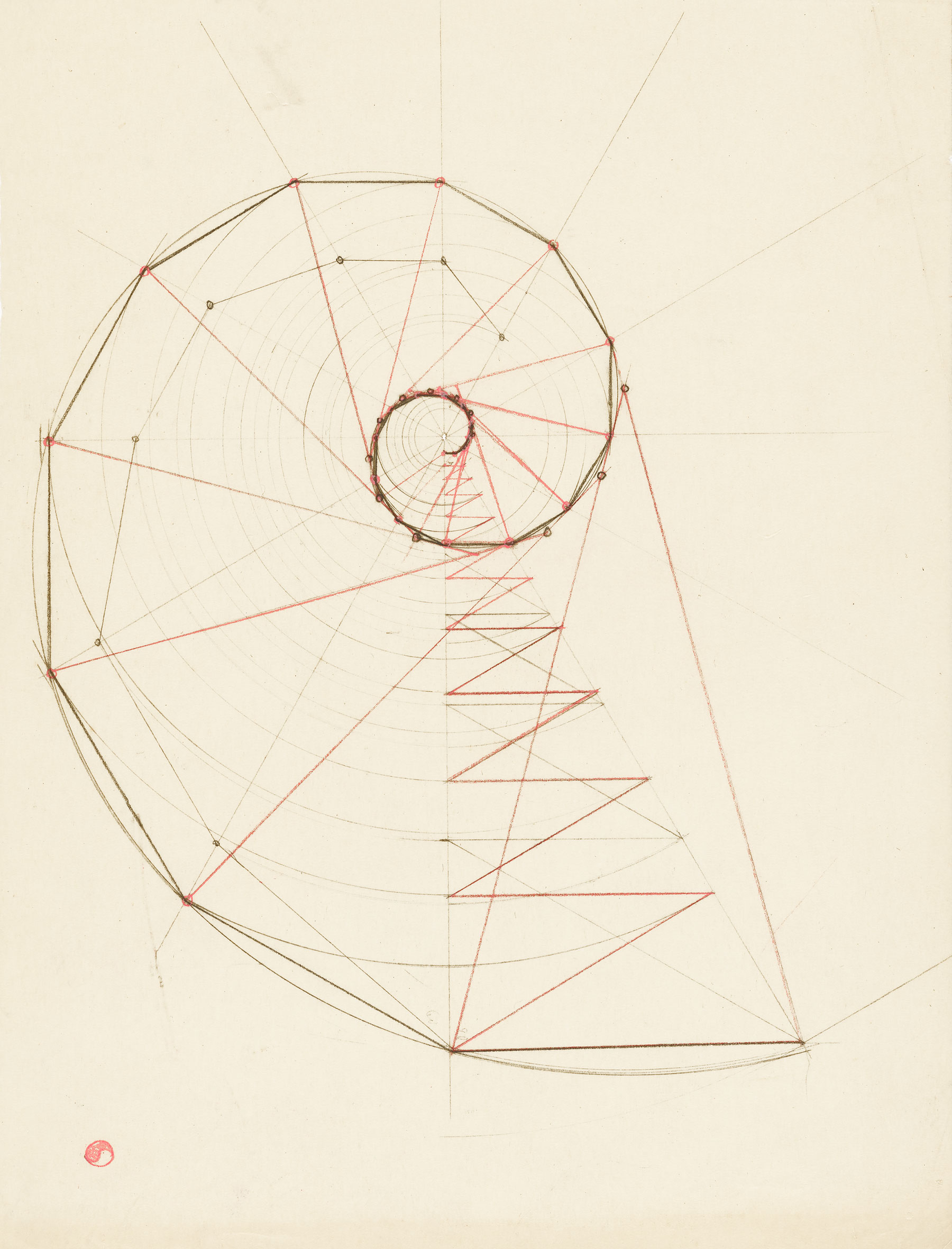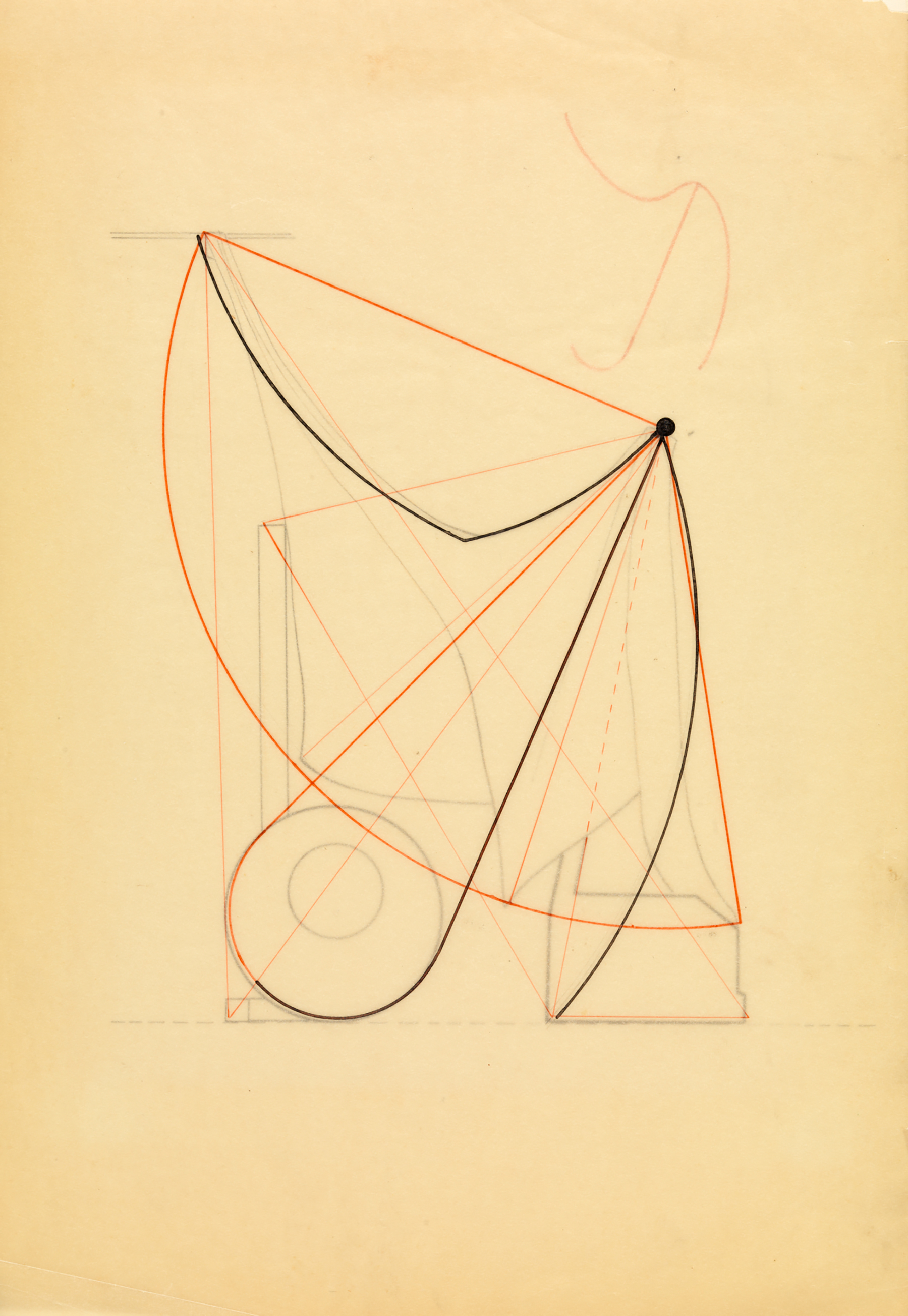Primary Forms
Assignments relating to abstract formal compositions serves to improve thinking and at the same time spurs the development of new techniques of representation.1
Vassily Kandinsky and Paul Klee began design instruction by analyzing the elements of pictorial composition as a set of polarities. The point was the most basic unit. Its “intense self-contained repose”2 was in direct contrast to the dynamic character of the line, which pressures the point to move in various directions. Lines can be active, passive, free, medial, straight, curved, angular, warm, cold, horizontal, vertical, or diagonal. When condensed or arranged in certain configurations, lines can form the third basic unit of design: the plane.
An anonymous student drawing from Kandinsky’s course in Dessau (fig. 20) illustrates the three primary planes: the circle, the square, and the triangle. The composition is anchored by an equilateral triangle drawn in red, whose points draw attention to the center of each plane.
 Fig. 20.
Fig. 20.Josef Albers would often challenge students to draw circles freehand in order to internalize the nature of each form.
An understanding of the internal dynamics of a given plane was crucial. As the product of a particular interaction among lines, every plane possessed a unique character. Exercises to determine the “planar impact” of lines were regularly assigned during formal instruction at the Bauhaus.3
For example, a student exercise from Klee’s course (fig. 21) maps six possibilities for the construction of a circle. Each diagram describes a unique process of formation, revealing distinct internal dynamics within outwardly identical circles. Josef Albers would often challenge students to draw such circles freehand in order to internalize the nature of each form. Afterward, students were instructed to check their intuitive work for accuracy with a compass or an angle. Itten adopted a similar method, instructing students to draw with both arms in different directions and then in the same direction, “so that the circle would be experienced as an evenly curved, continually moving line.”4
Subdividing the Square
Drawings by student Gertrud Preiswerk (figs. 22, 23) explore the formal properties of a square, with attention given to proportion, rhythm, weight distribution, and surface tension. Although made in Dessau, they echo the earliest teachings of Johannes Itten, who instructed students to divide a square with horizontal and vertical lines such that constrasting elements like light-dark, small-large, and wide-narrow could be applied to test the effect of progressively developing polarities.
Kandinsky considered the square divided into squares to be “the most primitive form of the division of a schematic plane” and therefore also one of the most useful.5 By practicing what Klee termed the progressive and regressive division of a surface, students could enumerate a plane’s basic forces or tensions, which could be harmonized or contrasted with other pictorial elements added to the composition.
Preiswerk’s proportion studies were carefully drawn in pencil, then inked over with pen to form uniform grids that modeled different weight values. In this drawing, the top row of white and black squares demonstrates high surface tension by employing the maximum contrast in tone, while the bottom row demonstrates how the same pattern painted in black and dark gray generates relatively low surface tension due to low contrast value. Itten reported that “through this process, I noticed that interested and talented students could make up to 44 tonal gradations between black and white visible.”6
Spiral Studies
The spiral was another useful form for training students in progressive proportion relationships. It derives clearly from one point and progresses either outward in widening steps or inward in decreasing increments, depending on one’s perspective. Where a circle maintains an equal radius, a spiral charts a different radial course. As Kandinsky observed, “The spiral is a line while the circle is a plane.”7
Unlike the eternally rotating circle, the progressive shift of the radius in a spiral results in directional movement, which Klee characterized in existential terms: “This direction determines either a gradual liberation from the center through freer motions, or an increasing dependence on an eventually destructive center. This is the question of life and death.”8
Unlike the eternally rotating circle, the progressive shift of the radius in a spiral results in directional movement, which Klee characterized in existential terms.
Spiral drawings created by an anonymous student (figs. 24, 25) demonstrate both radial and angular progressions toward the center, demarcated in red, blue, and graphite pencil.
Analytical Drawing
Analytical drawing exercises gave students the opportunity to observe the interaction of points, lines, and planes in everyday objects. Far from simply training artists to faithfully copy still-life arrangements, Kandinsky insisted that the study of nature revealed the forces of abstraction: “Natural laws of composition do not reveal to the artist the possibility of superficial imitation (which he frequently sees as the main purpose of the laws of nature) but, rather, the possibility of contrasting these laws with those of art.”9
Kandinsky’s analytical drawing practice found a parallel in Itten’s analytical study of old master paintings in the Preliminary Course. In this exercise, students drew grids over reproductions of canonical works of art in order to allow the most detailed analysis of form and color in the smallest gradient. The ultimate goal for both Itten and Kandinsky was the synthesis of external (natural) and internal (artistic) laws in the art of pictorial composition.
Two drawings created in Dessau by student Erich Mrozek reveal the complexity of Kandinsky’s assignment. First, students sketched a still-life arrangement in pencil—for example, a stool balancing a stack of boxes (fig. 26) or a curtain draped over various objects (fig. 27). The pencil sketch was then traced in ink and covered with a sheet of transparent paper. Starting at one point and spreading outward across the surface of the image, students mapped the linear tensions that structured the sketch below. Mrozek’s analysis reveals two utterly distinct abstractions generated from the study of a concrete scene.
Notes
- Johannes Itten, Mein Vorkurs am Bauhaus (Ravensburg: Otto Maier Verlag, 1963), 81. (German translation: Aufgaben zu den abstrakten Formkompositionen dienten der Verbesserung des Denkens und zugleich der Erarbeitung neuer Darstellungsmittel.) ↩
- Vassily Kandinsky, Point and Line to Plane (New York: Solomon R. Guggenheim Foundation, 1947), 57. ↩
- Paul Klee, Pedagogical Sketchbook (New York: Praeger, 1953), 20. ↩
- Johannes Itten, Mein Vorkurs am Bauhaus (Ravensburg: Otto Maier Verlag, 1963), 81. (German translation: So wurde der Kreis als gleichmäßig gebogene, kontinuierlich bewegte Linie erlebt.) ↩
- Vassily Kandinsky, Point and Line to Plane (New York: Solomon R. Guggenheim Foundation, 1947), 66. ↩
- Johannes Itten, Mein Vorkurs am Bauhaus (Ravensburg: Otto Maier Verlag, 1963), 21. (German translation: Dabei habe ich erlebt, daß interessierte und begabte Schüler bis zu 44 Tonstufen zwischen Schwarz und Weiß sichtbar machen konnten.) ↩
- Vassily Kandinsky, Point and Line to Plane (New York: Solomon R. Guggenheim Foundation, 1947), 81. ↩
- Paul Klee, Pedagogical Sketchbook (New York: Praeger, 1953), 53. ↩
- Vassily Kandinsky, Point and Line to Plane (New York: Solomon R. Guggenheim Foundation, 1947), 10. ↩

